Corey Miller
Style-agnostic evaluation of ASR using multiple reference transcripts
Dec 10, 2024



Abstract:Word error rate (WER) as a metric has a variety of limitations that have plagued the field of speech recognition. Evaluation datasets suffer from varying style, formality, and inherent ambiguity of the transcription task. In this work, we attempt to mitigate some of these differences by performing style-agnostic evaluation of ASR systems using multiple references transcribed under opposing style parameters. As a result, we find that existing WER reports are likely significantly over-estimating the number of contentful errors made by state-of-the-art ASR systems. In addition, we have found our multireference method to be a useful mechanism for comparing the quality of ASR models that differ in the stylistic makeup of their training data and target task.
Reverb: Open-Source ASR and Diarization from Rev
Oct 04, 2024

Abstract:Today, we are open-sourcing our core speech recognition and diarization models for non-commercial use. We are releasing both a full production pipeline for developers as well as pared-down research models for experimentation. Rev hopes that these releases will spur research and innovation in the fast-moving domain of voice technology. The speech recognition models released today outperform all existing open source speech recognition models across a variety of long-form speech recognition domains.
Quantification of stylistic differences in human- and ASR-produced transcripts of African American English
Sep 04, 2024



Abstract:Common measures of accuracy used to assess the performance of automatic speech recognition (ASR) systems, as well as human transcribers, conflate multiple sources of error. Stylistic differences, such as verbatim vs non-verbatim, can play a significant role in ASR performance evaluation when differences exist between training and test datasets. The problem is compounded for speech from underrepresented varieties, where the speech to orthography mapping is not as standardized. We categorize the kinds of stylistic differences between 6 transcription versions, 4 human- and 2 ASR-produced, of 10 hours of African American English (AAE) speech. Focusing on verbatim features and AAE morphosyntactic features, we investigate the interactions of these categories with how well transcripts can be compared via word error rate (WER). The results, and overall analysis, help clarify how ASR outputs are a function of the decisions made by the training data's human transcribers.
Updated Corpora and Benchmarks for Long-Form Speech Recognition
Sep 26, 2023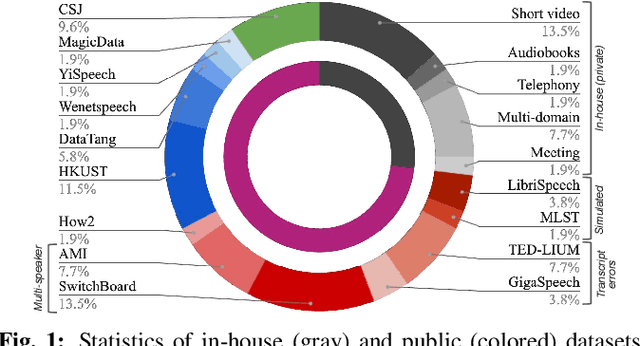
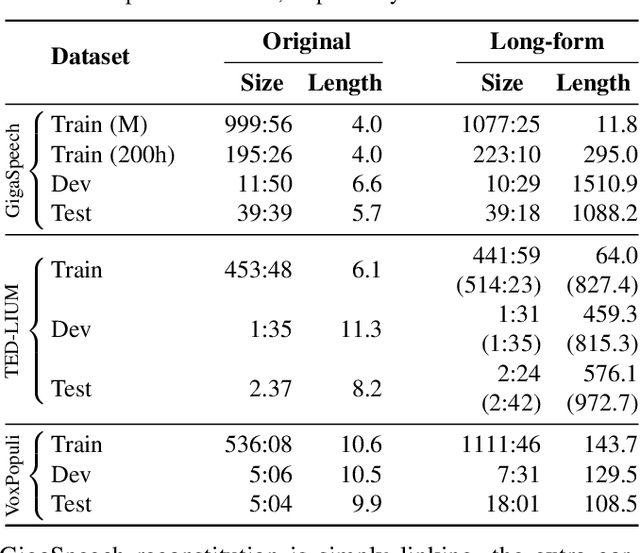


Abstract:The vast majority of ASR research uses corpora in which both the training and test data have been pre-segmented into utterances. In most real-word ASR use-cases, however, test audio is not segmented, leading to a mismatch between inference-time conditions and models trained on segmented utterances. In this paper, we re-release three standard ASR corpora - TED-LIUM 3, Gigapeech, and VoxPopuli-en - with updated transcription and alignments to enable their use for long-form ASR research. We use these reconstituted corpora to study the train-test mismatch problem for transducers and attention-based encoder-decoders (AEDs), confirming that AEDs are more susceptible to this issue. Finally, we benchmark a simple long-form training for these models, showing its efficacy for model robustness under this domain shift.
Earnings-22: A Practical Benchmark for Accents in the Wild
Mar 29, 2022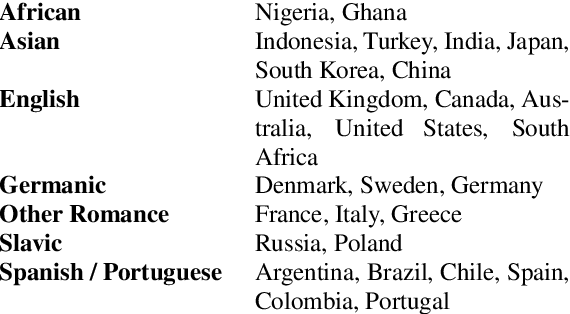
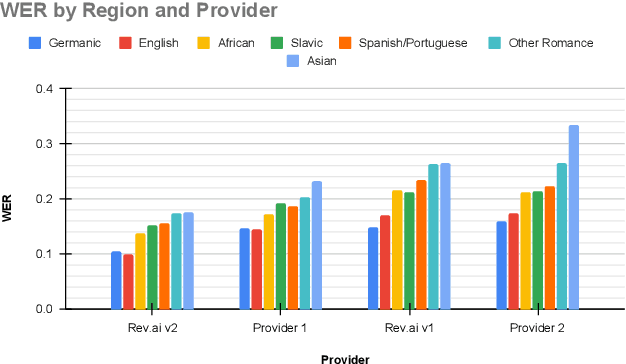
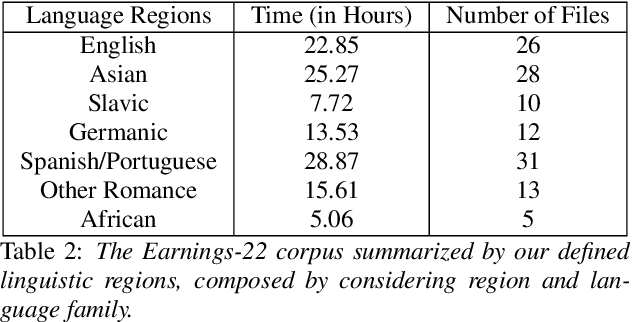

Abstract:Modern automatic speech recognition (ASR) systems have achieved superhuman Word Error Rate (WER) on many common corpora despite lacking adequate performance on speech in the wild. Beyond that, there is a lack of real-world, accented corpora to properly benchmark academic and commercial models. To ensure this type of speech is represented in ASR benchmarking, we present Earnings-22, a 125 file, 119 hour corpus of English-language earnings calls gathered from global companies. We run a comparison across 4 commercial models showing the variation in performance when taking country of origin into consideration. Looking at hypothesis transcriptions, we explore errors common to all ASR systems tested. By examining Individual Word Error Rate (IWER), we find that key speech features impact model performance more for certain accents than others. Earnings-22 provides a free-to-use benchmark of real-world, accented audio to bridge academic and industrial research.
A High Quality Text-To-Speech System Composed of Multiple Neural Networks
Dec 05, 1998
Abstract:While neural networks have been employed to handle several different text-to-speech tasks, ours is the first system to use neural networks throughout, for both linguistic and acoustic processing. We divide the text-to-speech task into three subtasks, a linguistic module mapping from text to a linguistic representation, an acoustic module mapping from the linguistic representation to speech, and a video module mapping from the linguistic representation to animated images. The linguistic module employs a letter-to-sound neural network and a postlexical neural network. The acoustic module employs a duration neural network and a phonetic neural network. The visual neural network is employed in parallel to the acoustic module to drive a talking head. The use of neural networks that can be retrained on the characteristics of different voices and languages affords our system a degree of adaptability and naturalness heretofore unavailable.
* Source link (9812006.tar.gz) contains: 1 PostScript file (4 pages) and 3 WAV audio files. If your system does not support Windows WAV files, try a tool like "sox" to translate the audio into a format of your choice
Variation and Synthetic Speech
Nov 17, 1997Abstract:We describe the approach to linguistic variation taken by the Motorola speech synthesizer. A pan-dialectal pronunciation dictionary is described, which serves as the training data for a neural network based letter-to-sound converter. Subsequent to dictionary retrieval or letter-to-sound generation, pronunciations are submitted a neural network based postlexical module. The postlexical module has been trained on aligned dictionary pronunciations and hand-labeled narrow phonetic transcriptions. This architecture permits the learning of individual postlexical variation, and can be retrained for each speaker whose voice is being modeled for synthesis. Learning variation in this way can result in greater naturalness for the synthetic speech that is produced by the system.
 Add to Chrome
Add to Chrome Add to Firefox
Add to Firefox Add to Edge
Add to Edge